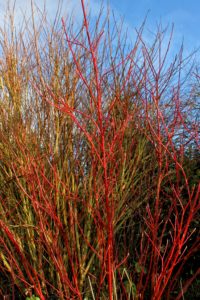No, this isn’t some kind of story about an inverted universe Cerberus, but actually a tree or shrub.
At this time of year we can be lacking in colour; from the interminable grey of these early months to the not yet burgeoning flora. But, there are a few exceptional bits of winter colour to find, including that of the dogwood. We have a dogwood shrub; Cornus alba, and the bright red stems are always a welcome sight throughout winter. But despite always admiring its striking scarlet limbs I’ve never really thought about its name before. And so, I did a little rummaging around.
The dogwood comes as either tree or shrub and there are quite a few myths around them – and wide-ranging at that. But three stood out as the most often recited and each has its own message to us.
One tale about the dogwood tree is that it provided the wood for the crucifix on which Jesus died. The story goes that, at that time, the dogwood was the tallest and strongest tree by far and having the sturdiest timber it was chosen to be made into the cross. The dogwood felt such sorrow and anguish at the task to which it had been made to perform that Jesus, dying upon it, felt the pain it experienced and as a kindness changed its kin so that all dogwoods would forever grow small and twisted and never be made to carry such a burden again. When Jesus was resurrected, the dogwood bloomed and blossomed in celebration. At the centre of the flower, there is a cluster of green which is seen as representation of the crown of thorns that Jesus wore upon the crucifix. Many people acknowledge the dogwood as a reminder of Jesus’ love and sacrifice.
Another tale regards Hectate, the goddess of protection and hidden knowledge. She was said to bring daily blessings and prosperity to family life and was herself a lover of solitude, never wanting to be centre of attention. Her symbols were dogs, torches and the new moon. But, that old rogue, Shakespeare was to be her undoing for he mentioned her name in connection with ‘dagger,’ most well-associated with MacBeth. At the time, daggers were often made of dagwood tree; the name, later changing to dogwood. The association of dogs, daggers and the dogwood tree and therefore with the goddess Hectate, meant that the damage was done and her mythology forever influenced. She became thereon to be perceived as the goddess of witchcraft and her name even became the root for the word, ‘hag’ meaning witch. This story of misrepresentation is used to warn us of how easily our characters can be destroyed through distortion. The dogwood here, is used to serve as a reminder to be alert so we are not taken advantage of by those who seek to betray or deceive us. But also to encourage us to view and experience our surroundings in quiet observation and that we can learn much about ourselves and others, by watching.
A third tale is one which came from among the Cherokee who told the story of a race of little people who lived in the forest and protected the tribe; they were the Dogwood people. These beings kept the children and elders safe, always with benevolence, not asking for anything in return and they were there to teach about being in harmony with the earth. Here, the dogwood spirit is associated with random acts of kindness.
The origin of the name, however most likely came about from the smooth, straight and incredibly strong limbs which were used to make skewers, daggers, arrows and the such. Skewers used to be called ‘dags’ or ‘dogs.’ The word ‘dog tree’ can be traced back to 1548 and later, in 1614 it was changed to dogwood, when it also acquired a secondary name of Hound’s Tree, the fruits of which were known as dogberries or houndberries.
Whatever your beliefs, I can’t see anything wrong in all of us taking heed of the stories and messages above: that there can be such empathy between humans and nature that it can be felt and acted upon and that great love will make sacrifices; that we should be alert to those who wish to harm us, but also to observe quietly to better learn about the world around us; and there is importance to being in harmony with nature, that we can act with benevolence and that random acts of kindness go a long way.